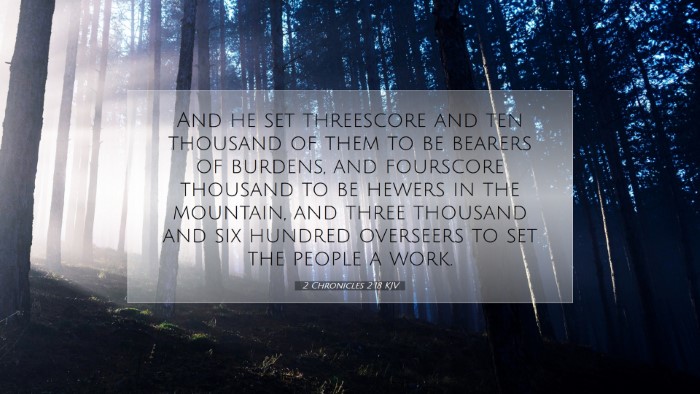Commentary on 2 Chronicles 2:18
Verse Insights:
2 Chronicles 2:18 states, "And he set threescore and ten thousand of them to be bearers of burdens, and fourscore thousand to be hewers in the mountains; and threescore and ten thousand to oversee them." This verse illustrates King Solomon's ambitious project of constructing the temple, showcasing not just his grand vision but also the significant labor and administrative organization required to bring that vision to fruition.
Contextual Background
This verse falls within the narrative of Solomon's reign, where he is preparing for the monumental task of building the temple in Jerusalem. It signifies the transition from David's military efforts to Solomon's peace-driven construction, highlighting the shift in focus from conquest to worship.
Insights from Matthew Henry
Matthew Henry emphasizes the meticulous planning involved in the temple's construction. He draws attention to Solomon's use of both skilled and unskilled labor, indicating the necessity of organization in achieving such a colossal endeavor. The different classes of laborers—those carrying burdens, those hewing stone, and the overseers—demonstrate the hierarchical structure Solomon established to ensure efficiency and order.
- Labor and Leadership: Henry notes that effective leadership requires recognizing different types of labor and the abilities of individuals, using Solomon as an example of wise governance.
- The Importance of Collaboration: The cooperation among various groups speaks volumes about the unity required in large projects, akin to the body of Christ working in harmony.
Insights from Albert Barnes
Albert Barnes explores the implications of such large-scale labor. He highlights that the sheer number of workers illustrates both the magnitude of the task and reflects the commitment of Solomon to glorify God through the building of the temple.
- Significance of Numbers: Barnes points out that 70,000 bearers of burdens and 80,000 hewers demonstrate the seriousness with which Solomon undertook this sacred task, indicating that monumental acts of worship require significant investment of resources and people.
- Divine Purpose: He also examines how Solomon’s workforce mirrors the divine order, suggesting that the church today should reflect similar organization in fulfilling its mission.
Insights from Adam Clarke
Adam Clarke offers a detailed understanding of the roles assigned to the workers. He asserts that these labor divisions indicate a well-thought-out plan, showcasing Solomon’s wisdom in administration.
- Workers as Servants of God: Clarke emphasizes that all labor should be seen as service to God, a principle that remains relevant for contemporary ministry efforts.
- Spiritual Parallel: He draws a parallel between the physical structure of the temple and the spiritual building of the church, asserting that just as the temple required labor, so does the church today.
Theological Reflections
From a theological standpoint, 2 Chronicles 2:18 invites reflection on the nature of service and community in God’s plans for worship. The collaborative effort of varied workers symbolizes the diverse gifts within the body of Christ, each serving a unique function aimed at glorifying God.
- Unity in Purpose: The diverse roles highlight the necessity for unity despite differences, a theme central to the New Testament understanding of the church.
- The Call to Service: This verse challenges believers today to recognize their part in God’s building project, whether through physical labor, spiritual gifts, or administrative roles.
Practical Application for Ministry
As pastors and church leaders engage in ministry, the lessons from 2 Chronicles 2:18 can guide them in effectively organizing their congregations for service.
- Recognizing Diversity: Leaders should encourage the use of varied gifts and roles within the church to fulfill God's mission, understanding that each member plays a critical part.
- Strategic Planning: Just as Solomon meticulously planned the construction of the temple, church leaders should seek wisdom in planning ministerial efforts, ensuring all contributions are valued and utilized for the kingdom.
Conclusion
2 Chronicles 2:18 serves as a profound reminder of the importance of organization, collaboration, and purposeful labor in the building of both physical and spiritual structures. By drawing from the insights of historical commentators like Matthew Henry, Albert Barnes, and Adam Clarke, we glean valuable principles that illuminate our understanding of service within the church today.


